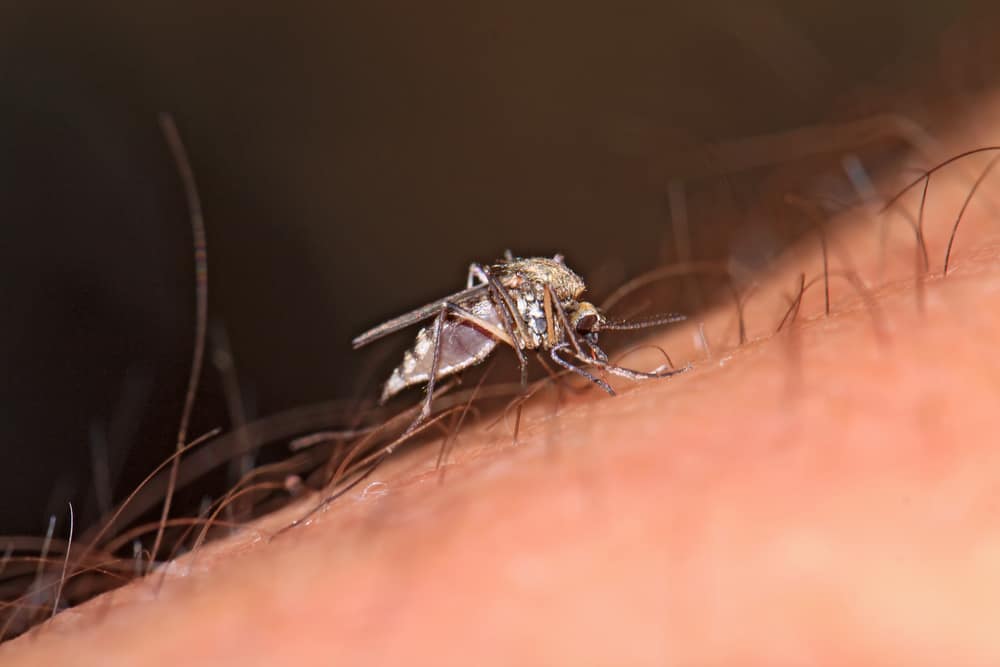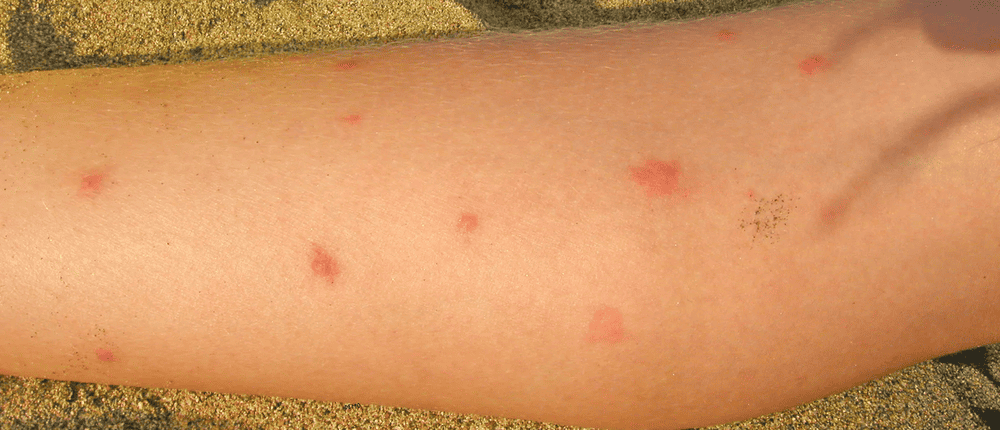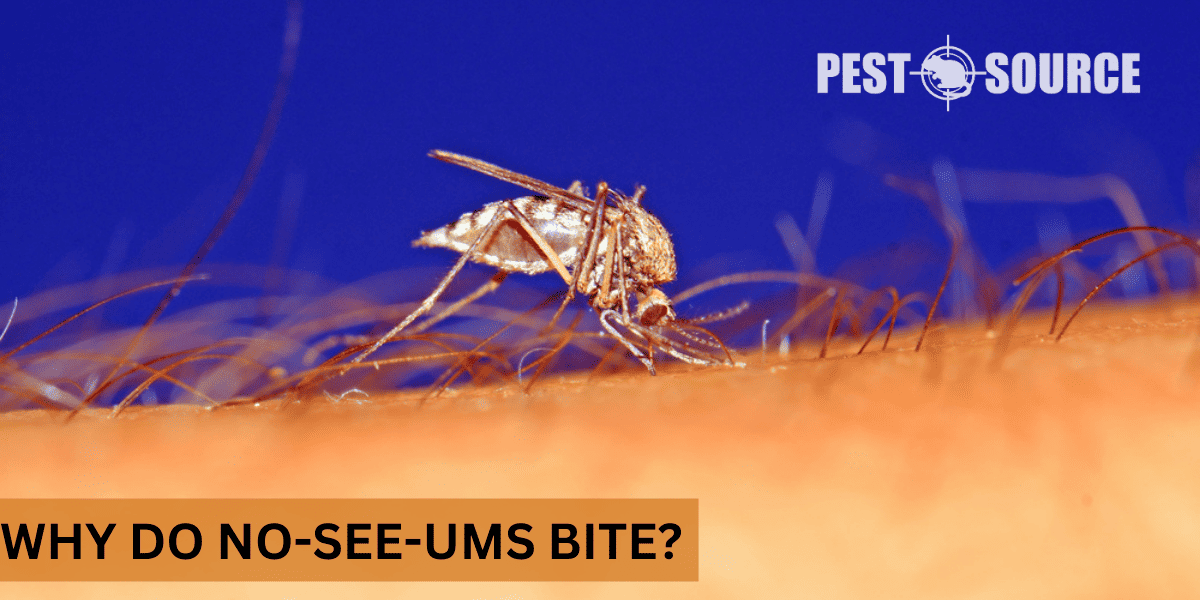As you enjoy the great outdoors, have you ever been harassed by some mysterious tiny biter you just couldn’t see? Chances are, you’ve met a no-see-um. These tiny, irksome pests are known for their bites, but why do they bite at all?
This comprehensive guide delves into the world of no-see-ums, exploring what they are, why they bite, their distinctive characteristics, and most importantly, how you can avoid their unwelcome attention. Let’s demystify these microscopic intruders so next time they don’t catch you off-guard.
POINTS
- No-see-ums, also called biting midges, are tiny insects that bite to procure a blood meal for egg production; only female no-see-ums bite.
- No-see-ums are attracted to carbon dioxide, body heat, moisture, lactic acid, and natural odors emitted by humans and animals. They also prefer dark, contrasting colors.
- There are over 4,000 species of no-see-ums, each with slightly different behaviors and characteristics. They all follow a life cycle of egg, larva, pupa, and adult.
- Common misconceptions about no-see-ums include their invisibility, all of them bite, and they only bite during dawn or dusk. In truth, they are just very small, only females bite, and individual species’ biting habits may vary.
- Minimizing the attraction of no-see-ums can be achieved through preventive measures such as wearing long-sleeved clothes, using insect repellents, installing fine-mesh screens, and keeping surroundings dry. There are also available products, like “Bite Me Not,” that might help deter no-see-um bites.
What Are No-See-Ums and Why Are They Noteworthy?
What is a no-see-um?
A no-see-um is a type of biting fly, so small that it often goes unnoticed until you feel the sting of its bite. Known by several names including biting midges, punkies, or sand flies, no-see-ums are part of the Ceratopogonidae family, a group of insects known for their nuisance factor and near-invisible size.
What are the defining characteristics of no-see-ums?

Because of their minuscule size, they are often difficult to identify without specialized equipment. On average, they measure between 1/25 and 1/8 of an inch. While their size may be negligible, their dark color and wedge-shaped wings are notable identifiers. Interestingly, it is the female no-see-um that bites as part of their reproductive process – they need blood in order to produce fertile eggs.
What Motivates No-See-Ums to Bite Humans and Animals?
Why do no-see-ums bite, and what is their primary objective in biting?
Like their mosquito kin, no-see-ums are attracted to the carbon dioxide that animals and humans exhale, the heat our bodies emit, and the moisture found on our skin. The primary objective of their bite is to gather a blood meal. This does not mean they are “out to get you”. Instead, their biting is an act of survival. Remarkably, it’s only the female no-see-ums that bite, as they need the blood to produce their eggs.
How do no-see-ums bite, and what mechanisms do they use to penetrate the skin?
Despite their size, NO-see-ums have a potent armory. Their mouthpart, composed of four cutting blades, is prepared to penetrate the skin, cutting and piercing our skin, allowing them to draw blood. Though it may be a relief to some, unlike mosquitoes, no-see-ums do not “inject” their saliva into the skin when they bite. Instead, they slice open the skin and suck up the blood that emerges as a result of these little incisions. The saliva is applied to the surface to prevent blood clotting during feeding.
What Specifically Attracts No-See-Ums to Humans?
Why do no-see-ums bite me, and why are no-see-ums attracted to me?

No-see-ums are attracted by a variety of factors. Carbon dioxide, warmth, moisture are natural magnets for these tiny pests. Your breath, sweat and bodily heat have components that act like beacons to the no-see-um. Furthermore, they’re attracted by lactic acid, a chemical generated by muscle movement.
What are no-see-ums attracted to?
Carbon dioxide, warmth, moisture, and lactic acid are all natural attractants to no-see-ums. They are also drawn to dark, contrasting colors, and the natural odors produced by both humans and animals. In short, they are drawn to anything that alerts them to potential blood meals.
Are There Different Kinds of No-See-Ums?
Are there different kinds of no-see-ums?
Yes, indeed there are. The term “no-see-ums” is a bit of a catch-all phrase for a variety of tiny, biting insects. The majority belong to the Ceratopogonidae family, which contains over 4,000 different species. Differences among these species can be incredibly minuscule and often require the eye of a trained entomologist to discern.
What distinguishes black no-see-ums from other types?
Black no-see-ums, also known as black fly gnats, are notable for their darker coloring compared to other no-see-ums. They belong to the Simuliidae family, where other no-see-ums are part of the Ceratopogonidae family. However, in terms of their feeding habit and nuisance factor, they are very similar to their counterparts.
Are there differences in the way that various kinds of no-see-ums behave or in what attracts them?
For the most part, the attractive elements for no-see-ums remain constant across species, including carbon dioxide, body heat, moisture, lactic acid, and natural odours. However, some variations may prefer feeding at different times of the day or may be more prevalent in certain geographic regions.
How Do No-See-Ums Reproduce, and What Role Does Blood Play in Their Reproductive Process?
How do female no-see-ums utilize the blood meal for egg production?
Once the female no-see-um has secured a blood meal, she goes to work using the protein and other nutrients found in the blood to produce eggs. Essentially, the blood meal fuels egg production, making it an indispensable part of the reproductive cycle for no-see-ums.
What are the lifecycle stages of no-see-ums?
The life cycle of a no-see-um consists of four stages: egg, larva, pupa, and adult. After consuming a blood meal, a female no-see-um can lay anywhere from 50 to 400 eggs, typically in wet or damp areas. The eggs then hatch into larva, before transitioning into the pupa stage. After pupating, they emerge as adults ready to continue the cycle.
Is there a “hatch ums” phase in no-see-ums’ lifecycle?
While there is no stage specifically referred to as “hatch ums”, this term could be considered synonymous with the stage at which larvae hatch from their eggs. This is an important phase in the life cycle of a no-see-um as it signifies the commencement of their journey from larvae to adulthood.
Misunderstandings and Misnomers Regarding No-See-Ums
What are common misconceptions about no-see-ums?
A common misconception about no-see-ums is that they are invisible. In reality, they are merely so small that they’re difficult to spot. However, under light, you’ll see them as tiny black specks. Another misunderstanding is that all no-see-ums bite. Surprisingly, it’s only the females that bite to obtain the necessary nutrients for egg production. Furthermore, some individuals incorrectly believe that no-see-ums only bite during dawn or dusk, when in reality, their biting habits may vary depending on the specific species.
Where does the name no-see-ums come from, and why do people often misspell it as “no see ums” and “noseeum”?
The name “no-see-ums” stems from the fact that these pests are so small that they often go unnoticed until their biting begins. This colloquial term reflects their near-invisibility and nuisance factor. Due to its phonetic nature, the spelling often varies, with “no see ums”, “noseeums”, and even “no-see-ems” being commonly used variants.
Can Humans and Animals Avoid or Minimize No-See-Um Bites?
What methods and strategies can be used to minimize the attraction of no-see-ums?

To minimize the attraction of no-see-ums, you can employ a few strategies. First, limit the amount of exposed skin by wearing long-sleeved shirts and long pants whenever you are outdoors. Use a reliable insect repellent, especially one that contains DEET or picaridin. Screens around patios or outdoor areas should have a very fine mesh to prevent entry of these minute pests. And remember, they are attracted to moisture, so fix any water leaks in your home and dry out any damp areas.
What are commercially available products like “bite me not” that might help to deter no-see-um bites?

Products such as “Bite Me Not” are generally natural essential oil-based formulations that claim to repel no-see-ums and other biting insects. They typically contain ingredients like citronella, lemongrass, peppermint, and lavender oils. While they may help deter no-see-ums to a certain extent, they may not be as effective as products containing DEET or picaridin. Always select a product based on its proven effectiveness, your individual needs, and preferably with the advice of a pest control professional.
Prevention and Control
After understanding why no-see-ums bite, the natural progression is to figure out how to deal with them. These tiny biting insects can be more than a mere annoyance, turning outdoor activities into an uncomfortable experience. While the biting mechanism and the reasons behind it are intriguing, they lead to the pressing question of how one can protect themselves from these persistent pests. If you’ve been bothered by no-see-ums and are looking for effective ways to eliminate or control them, learn how to get rid of no-see-ums in our comprehensive guide.
Conclusion
In dealing with no-see-ums, it’s important to understand that these tiny biters are a part of our natural ecosystem. Their bites can be quite discomforting, but remember, they’re not ‘out to get you’. They are simply living out their lifecycle. By employing preventative measures and using appropriate repellents, we can coexist with these incredibly tiny, yet notably pesky, members of our ecological community.



